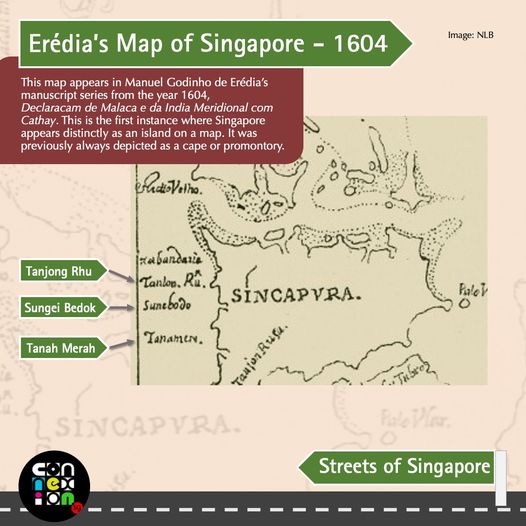Eredia's 1604 Map of Singapore
Many may think Singapore was a sleepy fishing village before Sir Stamford Raffles set foot in 1819, but the island was already a vital trading outpost 200 years before.A close look at the 1604 map of the Singapore Straits by Portuguese cartographer Manuel Godinho de Erédia offered clues of entrepot activity on the island during that time.

On the map, the name “Xabandaria” suggests that Singapore had a shahbandar here. Shahbandars, or harbourmasters, were foreigners appointed by local rulers and were responsible for warehousing, maintenance and welcoming merchants. The presence of a shahbandar in Singapore back then meant that there would be a fair amount of external trade taking place. On the same map, there are also semblances of street names we are familiar with today: Tanjon Ru (Tanjong Rhu), Tanamera (Tanah Merah) and Sunebudo (Sungei Bedok).
Tanjon Ru was located near the Kallang estuary which sheltered visiting ships. A number of late 16th-century Chinese blue and white ceramics dredged up in the Kallang River in the 1970s suggested the presence of Chinese ships in the area too.
The name Tanamera or “red land” in English is derived from the red lateritic cliffs along the coast that were visible from the sea. These cliffs were represented on maps to serve as a reference point for sailors. Today, Changi Airport Terminal 3 stands where the cliffs were after land reclamation works.
Also depicted on the map is Sunebudo or Bedok River. The name refers to the Malay word Bedoh, a wooden drum formerly used to issue the Islamic call to prayer, or Biduk, a riverine fishing boat. Over the years, the villages around the river grew to the sprawling Bedok town it is today. The river is now a canal that starts at Temasek Polytechnic and ends near the National Sailing Centre in East Coast Park, marking Bedok’s eastern border with Tampines. A mere 10 years after Erédia’s map was drawn, Singapore was raided and the island razed to the ground amidst strife between Johor and the Portuguese. But these names lived through the next two centuries before the arrival of Raffles in 1819. In subsequent maps, Tanah Merah, Tanjong Rhu and Bedok would appear once again.
With over 400 years of history behind them, these places have seen how Singapore overcame challenges and flourished to get where we are today. #StreetsOfSingapore
References: SGHistory (NLB), Singapore Bicentennial, Seven Hundred Years: A History of Singapore, Yeoweij.com, Singapore Infopedia (NLB), Roots.gov.sg (NHB)

